
One such grouping includes lithium (Li), sodium (Na), and potassium (K): These elements all are shiny, conduct heat and electricity well, and have similar chemical properties. In 1829, Johann Wolfgang Döbereiner observed that many of the elements could be arranged in groups of three, now known as “Döbereiner’s triads”. In 1789, Antoine Lavoisier arranged the 33 known chemical elements into four groups: gases, metals, nonmetals and earths. Spectroscopy remains a cornerstone of chemical analysis.Īs early chemists worked to purify ores and discovered more elements, patterns in the chemical behavior of elements emerged. Helium was first discovered by analyzing light from the sun in 1868 before it was found on Earth in 1882, through the spectral analysis of lava from Mount Vesuvius. The development of spectroscopy spurred discovery of additional new elements in the 1800s, including discovery of Cesium, Rubidium, and Helium. In the 1800s Sir Humphrey Davy discovered several alkali and alkaline earth metals and halogens through the use of electricity. It was not until the late 1700s that new elements began to be discovered (Ti, Zr, U, Te, Sr, Ce, Cr, Si, Se, Ce, Li, V, Th). In ancient times the known elements were carbon, iron, sulfur, gold, silver, copper, tin, lead, mercury and zinc.

There are many known elements, both naturally occurring and manmade. Predict some general properties of elements based on their location within the periodic table.Explain the organization of elements in the periodic table.By the end of this section, you will be able to:


 0 kommentar(er)
0 kommentar(er)
